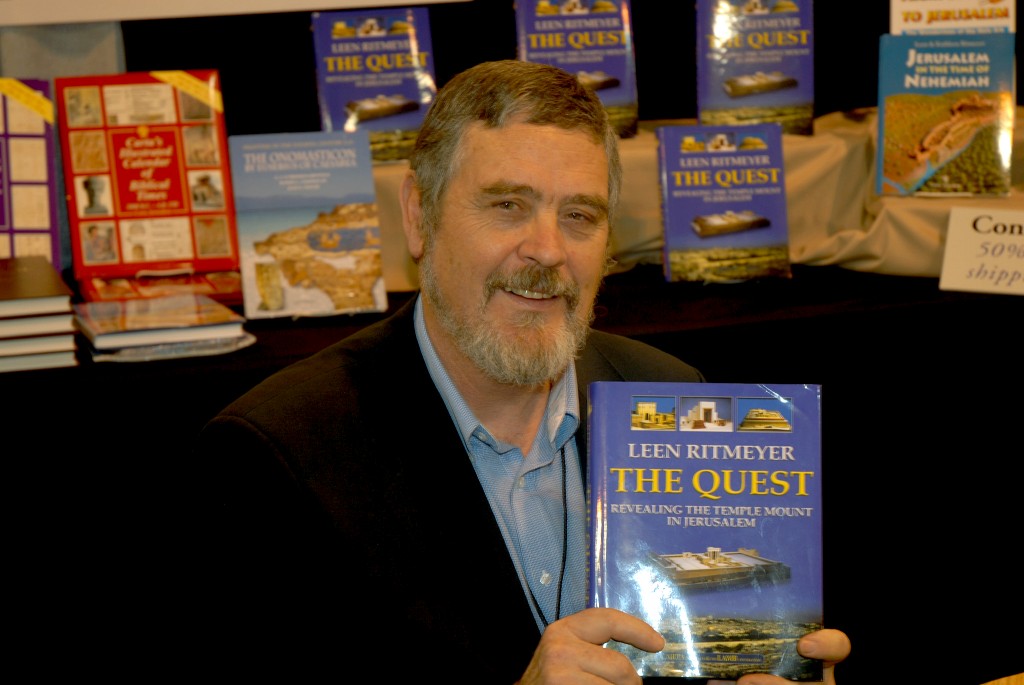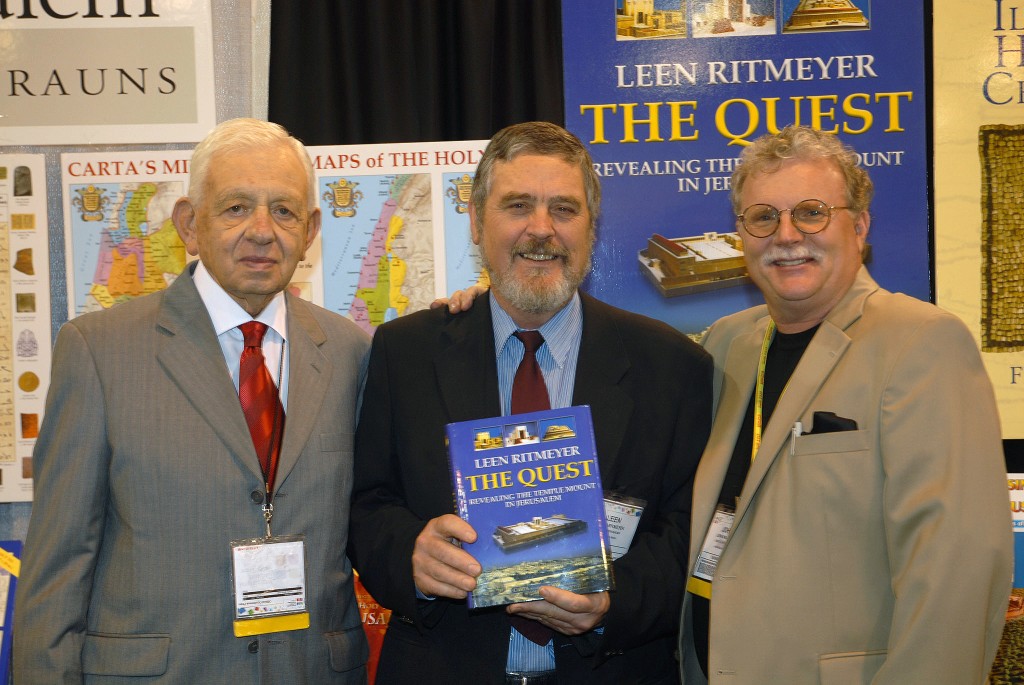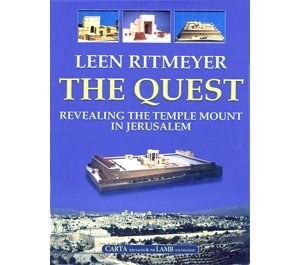In July 2006, my book The Quest: Revealing the Temple Mount in Jerusalem was published. The launch of The Quest took place at the International Christian Retail Show in Denver, USA.

I don’t know who was more excited to see this book in print, John E. Mancini of the Lamb Foundation who had sponsored me to write this book, Emanuel Hausman, Chairman of Carta Publishing in Jerusalem, or myself.
I dedicated the book to “John E. Mancini for sharing the vision to let the ancient stones tell their story and his unstinting support of The Quest.” We first met in Albuquerque, where Dr. Steven Collins, asked me to lecture on a regular basis as adjunct-professor at Trinity Southwest University in Albuquerque, NM, which he heads. I wrote this in the preface of The Quest:
For several years, Dr. Collins and I led tours to Israel. One participant, John E. Mancini, who with his wife Chris attended all our seminars and tours, expressed great interest in my research and was keen to make this material publicly available. John had already set up the Lamb Foundation to help Trinity and other projects, and during the fall of 1999 offered to help publish this book on the Temple Mount. I am delighted to thank him for the opportunity he gave me to devote myself to the presentation of my research carried out from the start of my archaeological career on the Temple Mount excavations in 1973. Thanks to John E. Mancini, to whom the book is dedicated, and all those who aided and accompanied me on this long and arduous journey, the public at large can now partake in the extensive documentation of Temple Mount history and archaeology provided by this volume and evaluate the proffered solutions to vexing questions.

Kathleen and I have experienced how pleasant it is to work with Carta, the Jerusalem publishers, on a number of publications. This book has, however, been a much more elaborate project. My thanks to all the people at Carta, their superb management and meticulous attention to the many details demanded by this title, especially to Barbara Laural Ball for her sensitive editing and general supervision of the project. Their proficiency can be seen on every page.
Ten years later, the book is still in demand and sells well and we have had many positive comments and favourable reviews. Yesterday, the 4th of July 2016, our book was chosen by the Temple Mount Sifting Project to top their list of the “10 Books To Read If You’re Into Archaeology and Israel” (even before the Hebrew Bible!).
This list was created by the staff of the Temple Mount Sifting Project in honor of their Book Week Campaign. It includes everything you need to know about Israel, Jerusalem, archaeology, and the Temple Mount.
1. The Quest: Revealing the Temple Mount in Jerusalem
This book is by Leen Ritmeyer. The recommendation was fought over by Gaby Barkay and Frankie Snyder. We will give them both credit.“No book is better suited to the study, understanding and development of the manmade plateau that is the focus of the world s interest the Temple Mount in Jerusalem. Ritmeyer’s experience as architect of the Temple Mount Excavations following the Six-Day War, coupled with his exploration of parts of the mount now hardly accessible and his doctoral research into the problems of the Temple Mount make him singularly qualified for the task.”
The other books on the list look very interesting too!


Congratulations, Leen, on the tenth anniversary of a fine volume! Thanks for your significant contribution to biblical studies.
Congratulations from Finland, too!
Whenever I recommend The Quest to people interested in the Temple Mount, I say that its author is the only scholar who is on a first-name-basis with every stone on the Mount. The Quest will remain THE authoritative study of the Mount for many more 10 year anniversaries!
Walt, that is very kind of you to say!
Mazal Tov on the continued success and well deserved devotion people have for “The Quest” I doubt it will ever be superseded by anybody unless its yourself as the Bible of all things Mount Moriah.
I remember being able back in the early 80s, to bribe any pleasant looking Arab visiting the mount to take me to the Eastern wall so as to be able to take a very quick 5 minute look at the interior side of the gates, before the police started to approach to shoo us away, but the baksheesh was worth every penny.
Its sad to think I am among few fortunate ones who saw the mount before the tractors came and started their destructive work on the underground Mosque. I still remember my last look at the pillar in Al Aqsa that had chips in it from the bulletts fired to kill King Abdullah who was with his grandson the then very young King Hussein.
Well, the fact that you are publishing the cartography books and such is a comfort. I wish you continued fortune and inspiration to keep us informed on everything as it affects the Mount up to this day. God bless you and your family and the work of your mind and hands.
Dear Dr.Ritmeyer!
After reading your book „Quest“ I now got a copy of your new book „the Temple mount“. Great stuff for all those who are interested in this topic and a good guide for those who want to walk around with the eyes of bible history in East-Jerusalem.
One question: Your very well illustrated book includes the Temple of Salomon.
Being just an interested layman I often heard historicans saying: there is no evidence for the very existence of a king named Salomon. There is even no sufficent evidence of the historic existence of David. Such important kings (of the bible) should be expected in historic or archiological sources. But they are not.
That’s what I have learned (to my disappointment).
But it seems that you are convinced of Salomons existence. Are there really historic or archiologic evidence and proof that this king is not just a fabricated person placed in jewish (bible) sources drawn at the Babylonian exodus in order to hold this folk together?
Thanks in advance if you find time to answer.
Ben Reuter
Ben,
There is evidence of King David’s Palace found in the City of David. Some skeptics would deny that, but many other scholars accept it. It all depends on whom you are listening to or reading about. Substantial remains of cities that were built by Solomon have also been excavated, such as Megiddo, Hazor and Gezer. My findings inside the Dome of the Rock also have evidence of the foundations of Solomon’s Temple. This Temple was destroyed by the Babylonians, so one cannot expect to find remains. A second temple was built after the Exile, which in turn was completely dismantled by Herod to make room for his new temple. Remember the old saying: Absence of evidence is not evidence of absence.
Dr Ritmeyer, Congratulations on your book’s 10 year anniversary. I also noticed your new book mentioned by another poster above was a featured book review in the most recent issue of BAR. I’m looking forward to getting my copy soon to read.
Wesley
Wesley,
Hope you will soon be able to enjoy it!
Dear Dr. Ritmeyer!
I have another question regarding the Golden Gate in the eastern wall.
The drawings in “The Quest” show a staircase supported by vaults leading down to street level and to another gate in the eastern city wall.
But wasn’t it this gate (todays Golden Gate) which play a role in the treatment of the Red Heifer and the scapegoat procedure? Would it be logic to assume that they were leading down the scapegoat on a staircase and then to send it “into the desert”?
Thanks for your response
Ben
Ben,
Yes, the scapegoat was led through the Shushan Gate (Golden Gate), down the arched stairway (one arch of which has been found), through the Miphkad Gate and down into the Kedron Valley, etc.
There never was a bridge, but an arched causeway according to Mishnah Parah 3.6.
Dr.Ritmeyer,
on page 395 of “The Quest” you write, that at the time of the second temple the site where the ark stood was still visible in the bedrock. The drawing on page 393 show a depression in the rock much like the one which you explored in the Dome of the Rock.
But on page 395 you continue with the Yoma which wrote that the shetiyah was HIGHER than the ground by three fingerbreadth.
This does not sound like a depression in the ground. Please explain
cheers from Ben
Ben,
I did’t say that, it is a quote from Mishnah Yoma 5.2. It is still correct when you read “ground” as “floor”. My section A-A on p.378 makes that clear.
Dear Dr. Ritmeyer, yet another “last question” while studiying your book.
You comment proposals for the location of the square temple mount e.g. on page 147ff of “The Quest”. But I didn’t find a comment about the “Fergusson Thesis” i.e. the so called “Southern Location”.
I think it was Tuvia Sagiv who also argued in a similar way a couple of years ago.
As far as I remember his main argument was that the priest were complaining about the fact that the King could observe the act of sacrifying in the temple court from one of the towers of the citadel. And this implicates that the temple must have been in a somewhat lower (southern) position.
You disprove Asher Kaufman’s “Northern Thesis” very convincing.
But are there any arguments against the “Southern Thesis”?
Ben
Ben, As Warren’s research was done to disprove Ferguson’s, I didn’t feel it necessary to do that as well. Tuvia’s ideas became known after my thesis was written and therefore it wasn’t relevant at the time.
Dr.Ritmeyer, are you in the know whether there were any search for the remanents of the southern 500 cubit wall in cistern 8 (southern section) or cistern 11 (nothern section)?